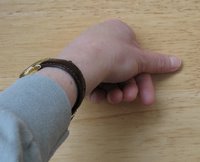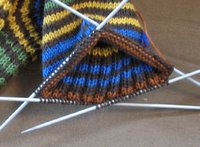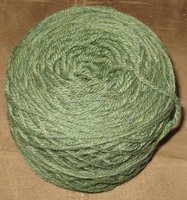Olympic Speed Knitting
 With the Knitting Olympics fast approaching, people are timing their knitting rates, training, choosing teams, and swatching for projects. It's going to be a fun time in blogland, but I am concerned that the post-Olympics posts will be about carpal tunnel and tendonitis. Thus, here are a few notes from a production knitter about knitting quickly and safely.
With the Knitting Olympics fast approaching, people are timing their knitting rates, training, choosing teams, and swatching for projects. It's going to be a fun time in blogland, but I am concerned that the post-Olympics posts will be about carpal tunnel and tendonitis. Thus, here are a few notes from a production knitter about knitting quickly and safely.1. Knitting is a sport. If you relax, you'll have a nice time and eventually get tired after much knitting, but if you are tense, you will damage your tendons. Take breaks, drink water, rotate your shoulders, and look off into the distance for a minute. If you get a cramp or soreness in your hands, run them under warm water and rub. When you aren't knitting, do alternate, non-grabbing activities with your hands, like playing a little piano or updating your blog.
 2. Tendon health. Avoid pinching (use scissors to trim the ends off string beans) and avoid hard gripping (use a jar opening tool). Above all, avoid bending your wrists backwards. Sleep with your arms straight, relaxed at your sides, not in a fetal position with your hands tucked under your chin, and not with your arms above your head. If you lean, lean on your fist with your wrist straight (see photo), not on your palm with your wrist bent. When I'm working the ends in on beadwork I use pliers to pull the needle because otherwise the tight pinching numbs my thumbs. Just one hard pinch can do it if you've been knitting all day, so be careful! If you have stiff shoulders or sore forearms, try my favorite salve, Aubrey's E-tomic Balm. A little goes a long way, it warms without burning, and it has a lovely spicy scent that, unlike most, doesn't give me a headache.
2. Tendon health. Avoid pinching (use scissors to trim the ends off string beans) and avoid hard gripping (use a jar opening tool). Above all, avoid bending your wrists backwards. Sleep with your arms straight, relaxed at your sides, not in a fetal position with your hands tucked under your chin, and not with your arms above your head. If you lean, lean on your fist with your wrist straight (see photo), not on your palm with your wrist bent. When I'm working the ends in on beadwork I use pliers to pull the needle because otherwise the tight pinching numbs my thumbs. Just one hard pinch can do it if you've been knitting all day, so be careful! If you have stiff shoulders or sore forearms, try my favorite salve, Aubrey's E-tomic Balm. A little goes a long way, it warms without burning, and it has a lovely spicy scent that, unlike most, doesn't give me a headache.3. Use good lighting. If your only source of light is the TV, you will get eye strain and a headache, so position a lamp where it provides lumens without glare. If you are reading a chart, use a clipboard, color pencils or pens, magnetic strip, or whatever works for you, and position the chart where you can see it easily.
4. Sit comfortably. I reach optimum speed while curled in my cushy couch with my feet up. If you aren't a lounge knitter, do support your spine, prop up elbows if needed, and sit centered. No twisting to see the TV: move the furniture so you're aligned.
5. Support your work. If you realize that you are hunching over because your knitting is heavy and your arms are weary, put a pillow in your lap to support the work. If you find yourself knitting on the go, wear a sweater and fasten the bulk of your knitting to your sweater with stitch holders (a heavy Aran works best). If you're knitting in the round, you can use a swivel hook or just flop it back and forth. I usually tuck the ball of yarn under my left arm, but you can hang it from your sweater or belt, put it in a small bag with a handle large enough to hang from your elbow, or stick it in a pocket. And yes, I have gone to the grocery store with a half-knit shawl and balls of yarn clipped to my sweater. They're used to me here and just ask what's on the needles this week. Beware of yarn-biting velcro on jackets!
6. Use the correct needle(s). If you are planning to knit the Balmoral in sportweight, order enough long circulars that you won't have to cram stitches. If you're going to knit something with a lot of k3tog's, dig in your stash for a needle with pointy ends so your hands don't cramp up from fighting with an Addi. If you have wide palms, you'll probably enjoy a circ with a longer needle, and vise versa. If you're enchanted with needle-free cabling but your yarn isn't tacky enough to hold and you end up pinching the stitches, indulge yourself and use a cable needle. Yes, needle-free cabling is cool, but it's a bother to fuss over dropped stitches picked up with a mistaken twist because a skater did a magnificent jump and you tugged the sweater a bit...
 7. Dpn's. Arrange the stitches so you can reach them easily. If you knit English and can reach with the yarn over a span of 18 stitches, but have to let go of the right needle if the span is more than 24 sts, then use an extra needle and distribute the stitches to maximize your comfort. That clenching of letting go and grabbing the needle again can cause horrid fatigue. Dpns are cheap, and it may be heresy but, unless I'm doing yarn overs, I often substitute a needle of the next size down if I'm short one.
7. Dpn's. Arrange the stitches so you can reach them easily. If you knit English and can reach with the yarn over a span of 18 stitches, but have to let go of the right needle if the span is more than 24 sts, then use an extra needle and distribute the stitches to maximize your comfort. That clenching of letting go and grabbing the needle again can cause horrid fatigue. Dpns are cheap, and it may be heresy but, unless I'm doing yarn overs, I often substitute a needle of the next size down if I'm short one. 8. Yarn health. Wind relaxed center-pull balls. A tightly wound ball blocks the yarn and when you wash your garment the yarn will return to its preferred length, often making the garment considerably smaller than expected. A tightly wound center-pull ball will also be more likely to burp clumps that proceed to tangle and waste your time. I usually wind from hank to ball, then wind the ball once or twice more to get a soft, squishy ball. If you don't own a ball winder, buy one or go to a friend's house and have a winding party with hers. (Bring cookies.)
8. Yarn health. Wind relaxed center-pull balls. A tightly wound ball blocks the yarn and when you wash your garment the yarn will return to its preferred length, often making the garment considerably smaller than expected. A tightly wound center-pull ball will also be more likely to burp clumps that proceed to tangle and waste your time. I usually wind from hank to ball, then wind the ball once or twice more to get a soft, squishy ball. If you don't own a ball winder, buy one or go to a friend's house and have a winding party with hers. (Bring cookies.)
9. As Margene says, it's the process!
A quick note. It's pouring rain today so no bird photos, sorry. Banner is a snippet of yesterday's dawn instead.

<< Home